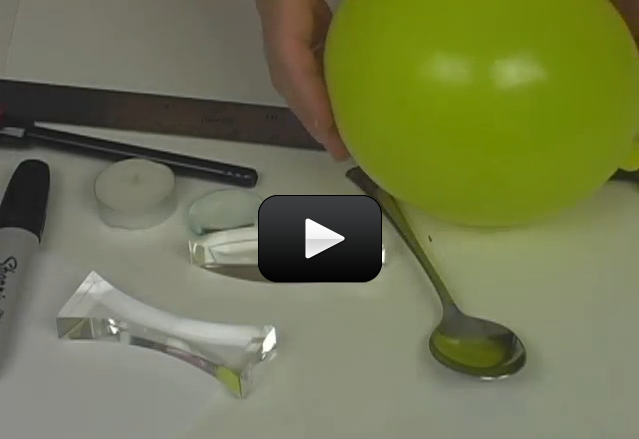In this lab, we are going to make an eyeball model using a balloon. This experiment should give you a better idea of how your eyes work. The way your brain actually sees things is still a mystery, but using the balloon we can get a good working model of how light gets to your brain.
Please login or register to read the rest of this content.


Votive candles are found at any drug store or grocery store (you can use any candle that you already have around the house – it doesn’t have to be a votive candle). The biconvex lens order link is in the main shopping list for this section here: https://www.sciencelearningspace2.com/category/shopping-list/unit-19-shop-list/
Hi. Where can I buy biconvex plastic lens and a votive candle? Thanks!
The reason it’s upside down is due to the shape/focal length of the lens, not the material it’s made of.
Does it matter if the lens is plastic or glass? We used a glass lens and the candle appeared upside down.
Sure thing! Try this.
Hi there. Any suggestions on where to get the lens? Thanks!
Yes, my team send you a private email when you first asked about the problem… I’ll have them contact you again. You can email us directly at science@superchargedscience.com if you don’t see their email to you (check your spam folder).
its still not working and i need to start science soon… not meaning to nag or anything but have you found out whats wrong yet?
I am sorry you’re having account trouble! I’ll have my team connect with you right away to get this worked out.
hi aurora! i did this experiment before so i know i have access, but now it is saying its for 9 + grades? in fact, it is saying that for everything! i dont know whether this is a glitch on the part of my computer but its very annoying as i cant access ANY experiments now. if you can help me i would be very grateful.
thank you!
Hi Aurora, This expirement is very cool but where can we get the biconvex plastic lens.
Thanks for the great program, Zachary
What a creative question! You are thinking really thinking like a scientist, which is great. Let’s start off with a little on how the eye works. Light goes through the cornea (outside part of your eye) and is projected onto the retina, which is kind of like a TV screen in the back of your eye. A message gets sent to the brain, which interprets it, and we can “see” something. If the retina becomes damaged, the person can’t see as well, and in some cases can’t see at all. Now, what your talking about is artificial vision. There have been some experiments, with some success, involving restoring vision in those with damaged retinas. The process involves artificially sending messages to the brain, the way the retina does in someone who can see. Here’s a great link with lots more information: http://science.howstuffworks.com/innovation/everyday-innovations/artificial-vision.htm. Keep having those big ideas!
Hi, my name is Angeline, I’m thirteen and I emailed you once last year. I have a question about something and I needed someone with an open mind and a knowledge of science. Not an easy thing to find so I thought of you. This will have a lot of gaps but I needed a place to start.
So anyway, I was wondering if we’ve figured out how the pupil works (that’s the black thing in your eye that let’s you see, right?) because if we have we could put the technology into something like swim goggles, then they could see in maybe in distance or shadows or heat vision, at least,. The goggles would either attatch into the brain, I have no idea how that would work, or, more realistically, send something like radio wave or something that the brain could understand. it wouldn’t to go very far and shouldn’t, just enough to get to the brain. It’s obvious that if that part of that brain was filled up with something else this would be useless, but if it were a new born or they just lost there vision I think it would be worth a shot.
What do you think?
Thanks, Angeline.